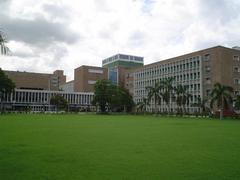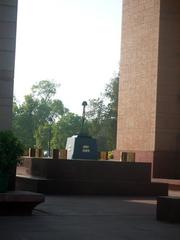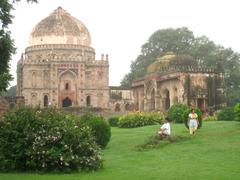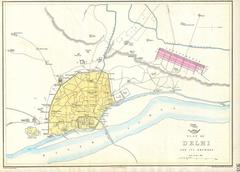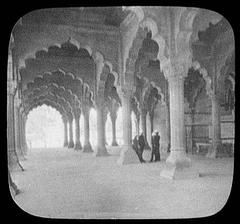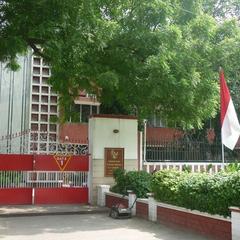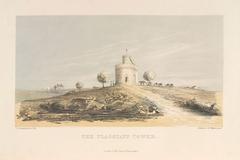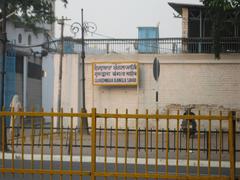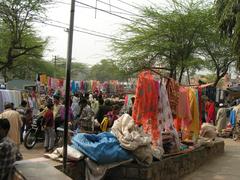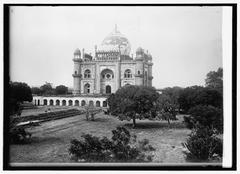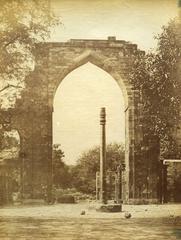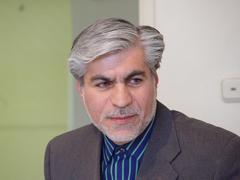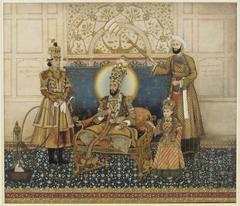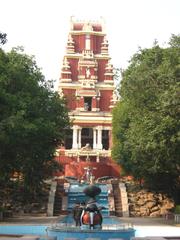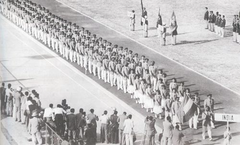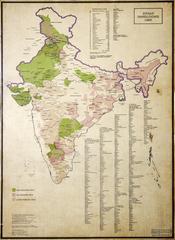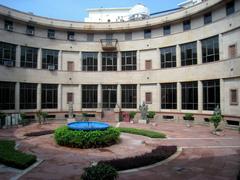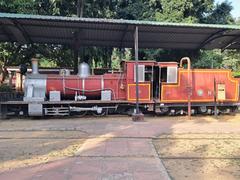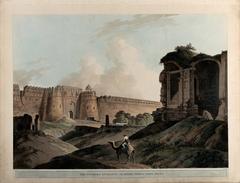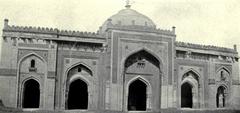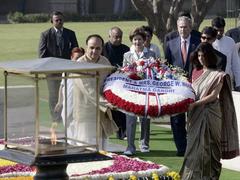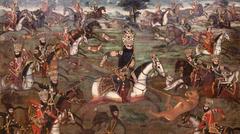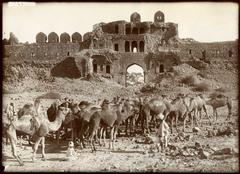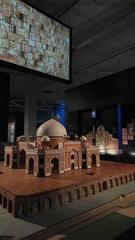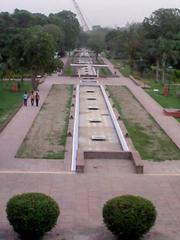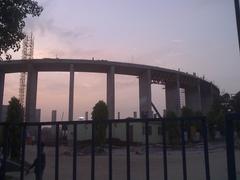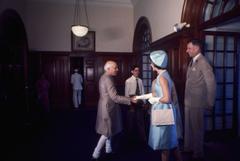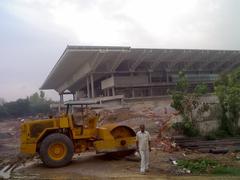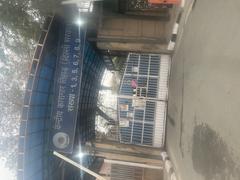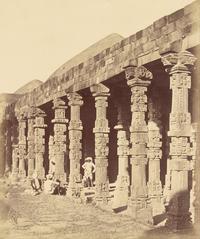Visiting Gandhi Smriti: Hours, Tickets, and Tips
Date: 18/07/2024
Introduction
Gandhi Smriti, located in the heart of New Delhi, is a deeply significant historical site that commemorates the life and legacy of Mahatma Gandhi. This site, formerly known as Birla House, offers a profound experience that immerses visitors in the final days of Gandhi’s life, his teachings, and his lasting impact on the world. The house, built in 1928 by the industrialist Ghanshyam Das Birla, became a frequent residence for Gandhi during his stays in Delhi. Following India’s independence in 1947, Gandhi moved to Birla House permanently, where he worked tirelessly to promote peace and unity in a newly partitioned nation. Tragically, it was here that he was assassinated on January 30, 1948, an event marked by a small pavilion known as the Martyr’s Column (Gandhi Smriti).
Table of Contents
- History and Significance of Gandhi Smriti
- Significance of Gandhi Smriti
- Visitor Information
- Attractions and Exhibits at Gandhi Smriti
- Accessibility
- Getting There
- Visitor Tips
- FAQ
Visiting Gandhi Smriti - History, Significance, and Visitor Information
Gandhi Smriti, located in New Delhi, is a must-visit historical site that commemorates the life and legacy of Mahatma Gandhi. This article explores the history, cultural significance, visitor information, and travel tips to help you plan your visit.
History and Significance of Gandhi Smriti
Gandhi Smriti, formerly known as Birla House or Birla Bhavan, stands as a poignant testament to Mahatma Gandhi’s life and principles. Located on Tees January Marg in New Delhi, India, this historic site marks the place where Mahatma Gandhi spent the last 144 days of his life and where he was assassinated on January 30, 1948.
Early Years of Birla House
The story of Gandhi Smriti begins with the construction of Birla House itself. This grand mansion was built in 1928 by Ghanshyam Das Birla, a prominent Indian industrialist and a close confidante of Mahatma Gandhi. The house, a symbol of wealth and modernity, became a frequent abode for Gandhi during his visits to Delhi. He often stayed here as a guest of the Birla family, using the house as a base for his political and social activities.
Gandhi’s Final Days at Birla House
In 1947, following India’s independence, Gandhi moved permanently to Birla House. He sought to heal the wounds of partition and promote peace and unity among the newly independent nation. It was during this time that he undertook numerous fasts, including his last fast in January 1948, to quell the communal violence that had erupted in the wake of partition.
The Assassination and its Aftermath
On January 30, 1948, while on his way to his daily prayer meeting in the Birla House gardens, Mahatma Gandhi was tragically assassinated by Nathuram Godse. The spot where he fell is marked by a small pavilion known as the Martyr’s Column, a solemn reminder of the tragic event.
Transformation into Gandhi Smriti
After Gandhi’s assassination, there was a widespread desire to preserve Birla House as a national memorial. The Birla family graciously handed over the property to the Government of India in 1971. In 1973, the house was officially dedicated to the nation as “Gandhi Smriti” (Gandhi Remembrance).
Significance of Gandhi Smriti
Gandhi Smriti is not just a museum or a historical landmark; it is a living memorial to the Mahatma’s life, teachings, and legacy. It serves as a -
- **Place of Pilgrimage - ** For people from all walks of life, Gandhi Smriti is a place of pilgrimage, where they come to pay homage to the Father of the Nation and draw inspiration from his life and message.
- **Center for Gandhian Studies - ** The Gandhi Smriti and Darshan Samiti, an autonomous body under the Ministry of Culture, Government of India, manages the memorial and promotes Gandhian values through various programs, exhibitions, and publications.
- **Repository of Gandhian Artifacts - ** The museum within Gandhi Smriti houses a rich collection of Gandhi’s personal belongings, photographs, letters, and other artifacts that offer a glimpse into his simple yet profound life.
- **Symbol of Peace and Non-Violence - ** Gandhi Smriti stands as a powerful symbol of peace and non-violence, reminding visitors of Gandhi’s unwavering belief in the power of truth, love, and non-violent resistance.
Visitor Information
Visiting Hours and Tickets
Gandhi Smriti is open to visitors from [insert visiting hours]. Admission is free/paid [insert ticket price if applicable].
Travel Tips
Gandhi Smriti is easily accessible via [insert transportation options]. Consider visiting early in the day to avoid crowds.
Nearby Attractions
While in New Delhi, you can also explore nearby historical sites such as [insert names of nearby attractions].
FAQ
- What are the visiting hours for Gandhi Smriti? Gandhi Smriti is open from [insert visiting hours].
- Is there an entry fee for Gandhi Smriti? Admission is free/paid [insert ticket price if applicable].
- What is the best time to visit Gandhi Smriti? Consider visiting early in the day to avoid crowds.
Conclusion
Gandhi Smriti is more than just a historical site; it is a living testament to the enduring legacy of Mahatma Gandhi. It serves as a poignant reminder of his sacrifice, his unwavering belief in peace and non-violence, and his enduring message of love, truth, and compassion. A visit to Gandhi Smriti is not just a journey into the past but also a call to action, inspiring visitors to embrace Gandhi’s ideals and work towards a more just and compassionate world.
Download our mobile app Audiala for more travel tips and updates on historical sites. Follow us on social media for the latest news and articles.
For more information on historical sites in New Delhi, check out our article on [insert related article]. For official updates, visit the Gandhi Smriti website [insert link].
Visiting Gandhi Smriti - Hours, Tickets, and Historical Insights in New Delhi
Visiting Gandhi Smriti - Hours, Tickets, and Historical Insights in New Delhi
Introduction
Gandhi Smriti, formerly known as Birla House, stands as a poignant testament to Mahatma Gandhi’s life and legacy. Located in New Delhi, this significant historical site offers an immersive experience into Gandhi’s life, philosophy, and enduring impact. This guide will cover essential information such as visiting hours, ticket details, and more.
Attractions and Exhibits at Gandhi Smriti
Visualizing Gandhi’s Final Days
Gandhi’s Room
Preserved in its original state, this simple room allows visitors to connect with the Mahatma’s austere lifestyle. His few belongings, including his spectacles, sandals, and a spinning wheel, serve as powerful reminders of his commitment to simplicity and self-reliance.
Martyr’s Column
Located on the exact spot where Gandhi was assassinated, this simple yet profound memorial is a poignant reminder of the tragedy that unfolded on January 30, 1948.
Steps to Mahatma’s Final Prayer Meeting
Leading from the house to the prayer ground, these steps are marked with poignant inscriptions of Gandhi’s final words, “Hey Ram,” adding a somber yet inspiring dimension to the visit.
Immersive Multimedia Exhibits
Eternal Gandhi Multimedia Museum
This state-of-the-art museum employs cutting-edge technology to present Gandhi’s life and teachings in an engaging and interactive manner. Through holographic projections, virtual reality experiences, and multimedia presentations, visitors embark on a captivating journey through Gandhi’s extraordinary life.
Gandhi in South Africa
This section of the museum focuses on Gandhi’s formative years in South Africa, where he first developed his philosophy of Satyagraha, or non-violent resistance. Exhibits showcase his struggles against racial discrimination and his evolution as a leader.
Gandhi’s Vision for India
This exhibit delves into Gandhi’s vision for an independent India based on principles of peace, non-violence, and social justice. Visitors gain insights into his views on various social and political issues, including poverty, untouchability, and communal harmony.
Art Gallery - A Tribute in Colors and Strokes
Gandhi Smriti Art Gallery
Located within the complex, the art gallery houses a remarkable collection of paintings, sculptures, and photographs depicting various facets of Gandhi’s life and work. These artworks, created by renowned artists, offer a unique perspective on the Mahatma’s legacy.
Library and Archives - Delving into Gandhian Literature
Gandhi Smriti and Darshan Samiti Library
A treasure trove of knowledge for scholars and enthusiasts alike, the library houses an extensive collection of books, journals, and documents related to Gandhi, his contemporaries, and the Indian independence movement.
Serenity Amidst the City
Gandhi Smriti Gardens
Providing a serene escape from the bustling city, the sprawling gardens surrounding the museum offer a tranquil space for reflection and contemplation. The lush greenery, vibrant flowers, and peaceful ambiance create an atmosphere conducive to absorbing the profound messages of Gandhi’s life.
Visitor Information
Location
5 Tees January Marg, New Delhi, India
Hours
Open daily from 10 - 00 AM to 5 - 00 PM, except Mondays and national holidays.
Entry Fee
Free entry for all visitors.
Photography
Photography is permitted within the complex, except in certain restricted areas.
Accessibility
The museum is wheelchair accessible, and facilities for visitors with disabilities are available.
Guided Tours
Guided tours are available in English and Hindi, providing deeper insights into the exhibits and Gandhi’s life.
Souvenir Shop
A souvenir shop within the complex offers a range of books, photographs, and other memorabilia related to Gandhi and his teachings.
Nearby Attractions
While visiting Gandhi Smriti, consider exploring other nearby historical sites in New Delhi such as India Gate, Rashtrapati Bhavan, and the National Museum.
Best Time to Visit
The best time to visit is during the cooler months between October and March to avoid the extreme summer heat.
How to Get There
Gandhi Smriti is well-connected by public transportation. It is accessible via metro, bus, and taxi services. The nearest metro station is Central Secretariat.
Safety Information
Always stay hydrated, especially if visiting during warmer months. Follow local guidelines and respect the sanctity of the memorial.
Tips for a Memorable Visit
-
**Allocate Sufficient Time - ** To fully appreciate the wealth of exhibits and information available, it is recommended to allocate at least 2-3 hours for your visit.
-
**Engage with the Multimedia Exhibits - ** Take advantage of the interactive multimedia displays to gain a deeper understanding of Gandhi’s life and philosophy.
-
**Reflect in the Gardens - ** Spend some time in the serene gardens surrounding the museum to reflect on Gandhi’s teachings and their relevance in today’s world.
-
**Visit the Library - ** If you are interested in delving deeper into Gandhian literature, be sure to visit the library and explore its extensive collection.
-
**Attend a Prayer Meeting - ** If possible, try to attend one of the prayer meetings held at the prayer ground to experience the spiritual atmosphere that was an integral part of Gandhi’s life.
FAQ
Is there an entry fee for Gandhi Smriti?
No, entry is free for all visitors.
What are the opening hours of Gandhi Smriti?
Gandhi Smriti is open daily from 10 - 00 AM to 5 - 00 PM, except on Mondays and national holidays.
How can I reach Gandhi Smriti?
Gandhi Smriti is accessible via metro, bus, and taxi services. The nearest metro station is Central Secretariat.
Are guided tours available?
Yes, guided tours are available in English and Hindi.
Can I take photographs inside Gandhi Smriti?
Yes, photography is permitted within the complex, except in certain restricted areas.
Conclusion
A visit to Gandhi Smriti is not merely a historical tour but a transformative experience. It offers a unique opportunity to connect with the Mahatma’s enduring legacy of peace, non-violence, and social justice, leaving visitors with a renewed sense of purpose and inspiration. Be sure to download the Audiala app for more travel tips and follow us on social media for updates.
Visuals and Media
Internal and External Links
- [Official Gandhi Smriti Website](http - //www.gandhismriti.gov.in)
Gandhi Smriti Visitor Guide
Introduction
Gandhi Smriti, a revered site in New Delhi, offers a poignant glimpse into the life of Mahatma Gandhi. This guide provides essential visitor information, including timings, ticket details, and accessibility features to enhance your visit.
Visitor Information
Timings and Days Open
Gandhi Smriti is open from 10 - 00 am to 5 - 00 pm, Tuesday to Sunday. The museum remains closed on Mondays and national holidays like Republic Day (January 26), Independence Day (August 15), and Gandhi Jayanti (October 2).
Entry Fee
Entry to Gandhi Smriti is free for all visitors.
Photography
Photography without flash is permitted within the museum premises. However, videography is strictly prohibited.
Guided Tours
Free guided tours are available in both English and Hindi. Visitors can inquire about the availability of guided tours at the information desk upon arrival.
Estimated Visit Duration
A typical visit to Gandhi Smriti can take anywhere from 1.5 to 2 hours. However, visitors interested in exploring the exhibits in detail and spending time in the serene surroundings may choose to stay longer.
Accessibility
Gandhi Smriti strives to provide a welcoming and accessible experience for all visitors. The following accessibility features are available -
Wheelchair Accessibility
- **Ramps - ** The museum has ramps at all entrances and throughout the complex, ensuring easy access for wheelchair users.
- **Wheelchairs - ** Wheelchairs are available free of charge at the entrance. Visitors can request assistance from the staff.
- **Accessible Restrooms - ** Designated restrooms for visitors with disabilities are available within the museum complex.
Visual Impairment Assistance
- **Braille Signage - ** Important information and directions are displayed in Braille throughout the museum.
- **Tactile Maps - ** Tactile maps are available at the information desk, providing a sense of the museum’s layout for visually impaired visitors.
Hearing Impairment Assistance
- **Sign Language Interpreters - ** While not always available on-site, visitors can request sign language interpreters in advance by contacting the museum administration.
Other Amenities
- **Drinking Water - ** Clean drinking water facilities are available within the museum premises.
- **Restrooms - ** Clean and well-maintained restrooms are available for visitors.
- **First Aid - ** Basic first aid facilities are available at the museum.
- **Parking - ** Limited parking space is available near the museum entrance. However, due to its location in a busy area, finding parking can be challenging.
Getting There
Gandhi Smriti is located in the heart of New Delhi, making it easily accessible by various modes of transport -
By Metro
The nearest metro station is Race Course on the Yellow Line of the Delhi Metro. The museum is a short walk (approximately 500 meters) from the metro station.
By Bus
Several Delhi Transport Corporation (DTC) buses ply on the route and stop near Gandhi Smriti. Visitors can check the DTC website or app for bus routes and timings.
By Taxi or Auto-Rickshaw
Taxis and auto-rickshaws are readily available throughout Delhi and can be hired to reach Gandhi Smriti. It is advisable to negotiate the fare beforehand or ensure the driver uses the meter.
By Car
While driving to Gandhi Smriti is possible, parking can be a challenge. It is recommended to use public transport or hire a taxi/auto-rickshaw for a hassle-free experience.
Visitor Tips
- **Dress Code - ** While there is no strict dress code, it is advisable to dress modestly out of respect for the sanctity of the place.
- **Silence - ** Maintain silence within the museum and memorial areas to preserve the serene atmosphere.
- **Footwear - ** Visitors are required to remove their footwear before entering the Martyr’s Column area and the room where Mahatma Gandhi was assassinated. Shoe racks are provided for convenience.
- **Hydration - ** Carry a water bottle, especially during the summer months, as Delhi can get quite hot.
- **Respectful Behavior - ** Refrain from touching or damaging any exhibits. Be mindful of other visitors and maintain a respectful demeanor throughout your visit.
- **Time Your Visit - ** To avoid large crowds, consider visiting during weekdays or early mornings.
- **Combine with Other Attractions - ** Gandhi Smriti is located close to other prominent landmarks like India Gate and Lodhi Garden. Visitors can combine their visit with these attractions for a more enriching experience.
FAQ
- Q - What are the opening hours of Gandhi Smriti?
- **A - ** Gandhi Smriti is open from 10 - 00 am to 5 - 00 pm, Tuesday to Sunday. It is closed on Mondays and national holidays.
- Q - Is there an entry fee for Gandhi Smriti?
- **A - ** No, entry to Gandhi Smriti is free for all visitors.
- Q - Are guided tours available at Gandhi Smriti?
- **A - ** Yes, free guided tours are available in both English and Hindi. Inquire at the information desk upon arrival.
By following these tips and utilizing the available accessibility features, visitors can ensure a memorable and meaningful experience at Gandhi Smriti, paying homage to the Father of the Nation and reflecting upon his enduring legacy.
Call to Action
For more travel guides and updates, download our mobile app Audiala, check out related posts, or follow us on social media.
Conclusion
A visit to Gandhi Smriti is more than just a historical tour; it is a transformative experience that offers a deep connection to the life and ideals of Mahatma Gandhi. The site stands as a powerful symbol of peace, non-violence, and social justice, encapsulating Gandhi’s unwavering belief in the power of truth and love. From the preserved simplicity of Gandhi’s room to the technologically advanced exhibits of the Eternal Gandhi Multimedia Museum, every aspect of Gandhi Smriti invites visitors to reflect on the Mahatma’s teachings and their relevance in today’s world. The serene gardens and the Martyr’s Column provide a space for contemplation and homage, making Gandhi Smriti a place of pilgrimage for people from all walks of life.
References
- Visiting Gandhi Smriti - History, Significance, and Visitor Information, 2024 Gandhi Smriti
- Visiting Gandhi Smriti - Hours, Tickets, and Historical Insights in New Delhi, 2024 Gandhi Smriti
- Gandhi Smriti Visitor Guide - Timings, Tickets, and Accessibility in New Delhi, 2024 Gandhi Smriti

